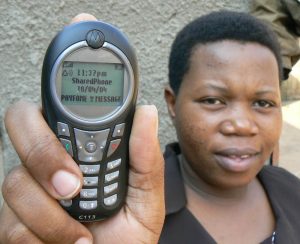Mobile Payment Systems

Photo by: Ken Banks/ kiwanja.net
Mobile payment systems have, in a relatively short period, been introduced in Kenya and produced an overwhelming success. By now, more than a third of monetary transactions are handled by the M-Pesa system which was only introduced in 2007. With very limited costs this system allows to transfer very small sums and has conquered a remarkable share of this market, including economic agents on the lower scale that before had no access to classical banking services. Its impacts on the economy seem to be huge and growing. The linking up to worldwide transfer systems currently underway is expected to increase its importance for the live of Kenya’s population. The availability of ever cheaper smart-phones for which Africa is the fastest growing market extends the technological bases and reduces the threshold for joining the system.
The overall success of the M-Pesa mobile payment in Kenya has, however, not been replicated in other African societies. On a smaller scale, the use of similar systems is observed in Ghana, Tanzania and Uganda, but with less market share if compared with Kenyan case.
The initial questions that will guide the analysis include the following:
History and experiences
What are the local experiences – good or bad – with banking and money transfer systems? What are the causes for the non-adaptation of modern mobile payment systems?
Needs
What are the needs at the individual or household level? What kind of financial services does the household use? At what costs and to what ends? Which conditions prepare these household (non-)decisions?
What kind of minimum coverage ratio is necessary for the system to get traction? What are the initial obstacles?
Adequate technology in relation to needs
Is adequate information available?
What is the level of confidence of the population in the use of the system in a context of fragile economies and pervasive by corruption?
Are there any cultural impediments to the introduction of mobile payment systems?
Supply
Is it a matter of access to the underlying technology? Are smartphones available at affordable prices? Is there network coverage? Are there cultural impediments?
Public policies
How do mobile payment systems figure in the overall financial policies? What are the microeconomic and macroeconomic impacts that use the type of system in the national economy?
What are the banking policies? How are they shaped? By whom, or under the influence of whom? Is there sufficient information?
Where are the specific policies located, at a central bank, ministry or other government institution? What kind of organisation is dedicated to the underlying technologies? Government controlled institutions or private enterprise? How is the sector regulated? What is the organisational landscape? Is there specific legislation concerning mobile payment systems?
How does the legal and regulatory situation evolve? What is the relationship between legislation and implementation of policies in this area?
International intervention
Are there international and national agencies that try to introduce these systems? What are their strategies? How do they act on the policy, programme and project levels, and at the national, regional and local levels? Are there already successes or failures of their interventions? What kind of communication processes happen within the communities?
Media
Are there public discussions in the media or on social media? Who does the agenda-setting? How do the media treat the money transfer and banking systems? Do mobile payment systems figure in the public discourse?
